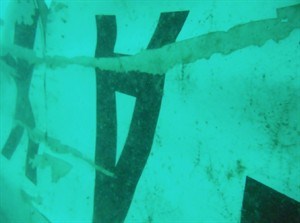
In this undated underwater photo released by Indonesia's National Search And Rescue Agency (BASARNAS) on Wednesday, Jan. 7, 2015, the part of the wreckage that BASARNAS identified as of the ill-fated AirAsia Flight 8501 is seen in the waters of the Java Sea, Indonesia. Divers and an unmanned underwater vehicle spotted the tail of the missing AirAsia plane in the Java Sea on Wednesday, the first confirmed sighting of any major wreckage 11 days after Flight 8501 disappeared with the passengers and crew members on board. (AP Photo/BASARNAS)
Republished January 07, 2015 - 6:04 PM
Original Publication Date January 06, 2015 - 9:40 PM
PANGKALAN BUN, Indonesia - The tail section of the AirAsia passenger jet that crashed late last month is upside down and partially buried in the sea floor, and experts are trying to figure out how to remove the plane's black boxes from it, an Indonesian official said.
Divers and an unmanned underwater vehicle on Wednesday spotted the tail of the plane that crashed into the Java Sea with 162 people on board. It is an important finding because the jet's black boxes — which should help pinpoint the cause of the crash — are located in that part of the aircraft.
At least six ships with equipment that can detect underwater objects and the plane's black boxes, back up by nine warships, are working in the area where the tail of was spotted, said Suryadi B. Surpiyadi, a search and rescue operation co-ordinator from an air force base in Pangkalan Bun, close to the search area,.
Suryadi said the registration number, PK-AXC, and part of the AirAsia logo proved it was the plane. He said two Indonesian military divers showed how the tail plunged into muddy seabed upside down.
"Expert teams from Indonesia and France are now looking for a technique on how to find and lift the black boxes from the plane's tail in such a position," Suryadi said.
The tail section was located about 9 kilometres (nearly 6 miles) from where Flight 8501 lost contact Dec. 28,
Tony Fernendes, AirAsia's chief executive officer, welcomed the news. He tweeted, that if it is the tail section then the cockpit voice and flight data recorders, or black boxes, "should be there."
He said the airline's priority still is to recover all the bodies "to ease the pain of our families."
The carrier, meanwhile, said families of those killed would be compensated in accordance with Indonesian laws.
Each will receive $100,000 (1.25 billion rupiah), Sunu Widyatmoko, president of AirAsia Indonesia, told reporters in Surabaya.
So far, 40 corpses have been found, but time is running out, because after about two weeks, most corpses will sink, said Anton Castilani, head of Indonesia's disaster identification victim unit, and there are already signs of serious decomposition. Officials are hopeful many of the more than 122 bodies still unaccounted for will be found inside the fuselage, which is believed to be lying near the tail.
The Airbus A320 went down halfway through a two-hour flight between Indonesia's second-largest city of Surabaya and Singapore, killing everyone on board. It is not clear what caused the crash, but bad weather is believed to be a contributing factor.
Just before losing contact, the pilot told air traffic control he was approaching threatening clouds, but was denied permission to climb to a higher altitude because of heavy air traffic. No distress signal was issued.
Finding the black boxes will be key to the investigation. They provide essential information about the plane along with final conversations between the captain and co-pilot. The ping-emitting beacons still have about 20 days before their batteries go dead, but high waves had prevented the deployment of ships that drag "ping" locators.
Sonar-equipped ships involved in the massive international hunt have identified what they believe to be the fuselage of the plane in recent days. Five other big objects have been found on the floor of the ocean, though no visual confirmation has been obtained yet. Smaller pieces of the plane, such as seats and an emergency door, have been collected from the surface.
The water in the Java Sea is relatively shallow at about 30 metres (100 feet) deep, but this is the worst time of year for a recovery operation because of monsoon rains and wind that create choppy seas and blinding silt from river runoff.
___
Associated Press writers Niniek Karmini, Ali Kotarumalos and Margie Mason in Jakarta contributed to this report.
News from © The Associated Press, 2015